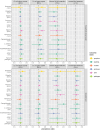This is a preprint.
Associations between fecal contamination of the household environment and enteric pathogen detection in children living in Maputo, Mozambique
- PMID: 40162287
- PMCID: PMC11952620
- DOI: 10.1101/2025.03.11.25323794
Associations between fecal contamination of the household environment and enteric pathogen detection in children living in Maputo, Mozambique
Update in
-
Associations between Fecal Contamination of the Household Environment and Enteric Pathogen Detection in Children Living in Maputo, Mozambique.Environ Health (Wash). 2025 Apr 11;3(7):757-767. doi: 10.1021/envhealth.4c00283. eCollection 2025 Jul 18. Environ Health (Wash). 2025. PMID: 40704083 Free PMC article.
Abstract
Environmental exposure to enteric pathogens is generally assessed using fecal indicators but relationships between markers of fecal contamination and actual exposure to enteric pathogens remain poorly characterized. We investigated whether Escherichia coli and two human fecal markers (HF183 and Mnif) in urban Mozambican household soil and drinking water were associated with detection in child stool of eight bacteria, three viruses, and three protozoa measured by multiplex reverse-transcription PCR and soil transmitted helminths assessed by microscopy. We used mixed-effects logistic regression with marginal standardization to obtain a pooled estimate of the overall indicator-pathogen relationship while simultaneously estimating pathogen-specific associations that accounted for assessing multiple pathogens per sample. At least one pathogen was detected in 88% (169/192) of child stools. Increasing drinking water E. coli gene concentration was associated with higher Ascaris prevalence, while human HF183 in drinking water was weakly associated with lower prevalence of the most common pathogens but was infrequently detected. No fecal marker in soil was clearly associated with any pathogen. We did not find evidence to support human markers as reliable indicators of enteric pathogen carriage in a high-prevalence domestic setting and recommend targeting enteric pathogens directly.
Keywords: Bayesian g-formula; Water, sanitation, and hygiene (WASH); diarrhea; enteric disease; helminthiasis; marginal standardization; microbial source tracking (MST); molecular pathogen detection.
Figures

Similar articles
-
Associations between Fecal Contamination of the Household Environment and Enteric Pathogen Detection in Children Living in Maputo, Mozambique.Environ Health (Wash). 2025 Apr 11;3(7):757-767. doi: 10.1021/envhealth.4c00283. eCollection 2025 Jul 18. Environ Health (Wash). 2025. PMID: 40704083 Free PMC article.
-
Is detection of enteropathogens and human or animal faecal markers in the environment associated with subsequent child enteric infections and growth: an individual participant data meta-analysis.Lancet Glob Health. 2024 Mar;12(3):e433-e444. doi: 10.1016/S2214-109X(23)00563-6. Lancet Glob Health. 2024. PMID: 38365415 Free PMC article.
-
Interventions to improve water, sanitation, and hygiene for preventing soil-transmitted helminth infection.Cochrane Database Syst Rev. 2022 Jun 21;6(6):CD012199. doi: 10.1002/14651858.CD012199.pub2. Cochrane Database Syst Rev. 2022. PMID: 35726112 Free PMC article.
-
Deworming drugs for soil-transmitted intestinal worms in children: effects on nutritional indicators, haemoglobin and school performance.Cochrane Database Syst Rev. 2012 Jul 11;(7):CD000371. doi: 10.1002/14651858.CD000371.pub4. Cochrane Database Syst Rev. 2012. Update in: Cochrane Database Syst Rev. 2012 Nov 14;11:CD000371. doi: 10.1002/14651858.CD000371.pub5. PMID: 22786473 Updated.
-
Water, sanitation, hygiene, and soil-transmitted helminth infection: a systematic review and meta-analysis.PLoS Med. 2014 Mar 25;11(3):e1001620. doi: 10.1371/journal.pmed.1001620. eCollection 2014 Mar. PLoS Med. 2014. PMID: 24667810 Free PMC article.
References
-
- Liu J.; Platts-Mills J. A.; Juma J.; Kabir F.; Nkeze J.; Okoi C.; et al. Use of Quantitative Molecular Diagnostic Methods to Identify Causes of Diarrhoea in Children: A Reanalysis of the GEMS Case-Control Study. The Lancet 2016, 388 (10051), 1291–1301. 10.1016/S0140-6736(16)31529-X. - DOI - PMC - PubMed
-
- Platts-Mills J. A.; Liu J.; Rogawski E. T.; Kabir F.; Lertsethtakarn P.; Siguas M.; et al. Use of Quantitative Molecular Diagnostic Methods to Assess the Aetiology, Burden, and Clinical Characteristics of Diarrhoea in Children in Low-Resource Settings: A Reanalysis of the MAL-ED Cohort Study. The Lancet Global Health 2018, 6 (12), e1309–e1318. 10.1016/S2214-109X(18)30349-8. - DOI - PMC - PubMed
-
- Luby S. P.; Rahman M.; Arnold B. F.; Unicomb L.; Ashraf S.; Winch P. J.; et al. Effects of Water Quality, Sanitation, Handwashing, and Nutritional Interventions on Diarrhoea and Child Growth in Rural Bangladesh: A Cluster Randomised Controlled Trial. The Lancet Global Health 2018, 6 (3), e302–e315. 10.1016/s2214-109x(17)30490-4. - DOI - PMC - PubMed
-
- Null C.; Stewart C. P.; Pickering A. J.; Dentz H. N.; Arnold B. F.; Arnold C. D.; et al. Effects of Water Quality, Sanitation, Handwashing, and Nutritional Interventions on Diarrhoea and Child Growth in Rural Kenya: A Cluster-Randomised Controlled Trial. Lancet Glob Health 2018, 6 (3), e316–e329. 10.1016/s2214-109x(18)30005-6. - DOI - PMC - PubMed
-
- Humphrey J. H.; Mbuya M. N. N.; Ntozini R.; Moulton L. H.; Stoltzfus R. J.; Tavengwa N. V.; et al. Independent and Combined Effects of Improved Water, Sanitation, and Hygiene, and Improved Complementary Feeding, on Child Stunting and Anaemia in Rural Zimbabwe: A Cluster-Randomised Trial. Lancet Glob Health 2019, 7 (1), e132–e147. 10.1016/s2214-109x(18)30374-7. - DOI - PMC - PubMed
Publication types
Grants and funding
LinkOut - more resources
Full Text Sources
